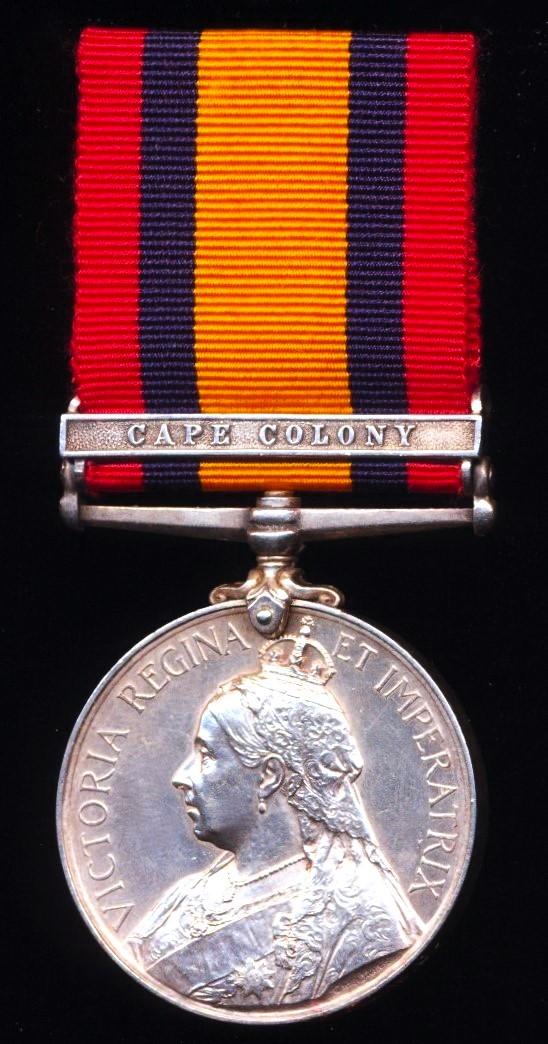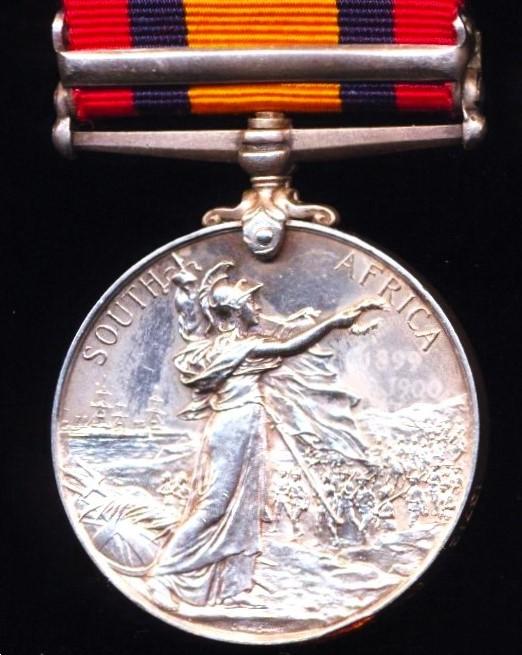Queens South Africa Medal 1899-1902. Silver issue with clasp 'Cape Colony' (13712 Cpl A. Brown. R.A.M.C.)
The recipient was a Medical Student - later Doctor 1905 - who was a 'Volunteer' serving with the privately funded Edinburgh & East of Scotland Hospital, in South Africa 1900
Alfred Brown, son of John Brown (a Paper Merchant & Printer) & Caroline Patience Bailey Brown (nee Salway) was a native of Edinburgh, Scotland, where he was born on, 16 November 1878. In 1881, Alfred lived with his family at, 17 Lutton Place, Newington, Edinburgh. After qualifying as a Doctor, Alfred - described as a Physician - moved to England, where in he married. In later years, Alfred and his family settled in Minchinhampton, Gloucestershire, where for many years he was a well known Doctor - in 1939, residing at, Highcroft, Park Terrace, Minchinhampton, Gloucestershire, England. Alfred Brown died on, 18 January1951, at which time he is recorded as having been residing at, Spencer Cottage, Minchinhampton, Gloucestershire, England
Medal & clasp verification: Entitlement to the medal and clasp is confirmed per the below cited campaign medal roll of the Edinburgh & East of Scotland Hospital
- QSA medal and clasp: WO 100/225
Important: The recipients regimental number being in the unique block of only 15 x regimental numbers 13700-13715 allocated to the Scottish Volunteers, all of whom were members of the Edinburgh Company Volunteer Medical Service Corps, and whom were all undergraduate medical students studying at Edinburgh University
Alfred Brown was a 21-year-old medical student from St. Lennard’s, Edinburgh when he attested for service in the Royal Army Medical Corps. He served for a total of 275 days of which he spent 216 days in South Africa. Medal and 1 clasp is confirmed on the Edinburgh and East of Scotland Hospital roll
The recipient's service record is extant and accessible at The National Archives
The Edinburgh and East of Scotland Hospital: Was one of 7 x privately funded hospitals that served in South Africa during the South African War, of those two were Scottish, viz The Edinburgh and East of Scotland Hospital, and the Scottish Hospital. While both hospitals compiled and returned their own campaign medal rolls, only the Scottish Hospital had medals named issued named to that unit, by contrast the recipients, military and civilian who served with The Edinburgh and East of Scotland Hospital, had their medals named to their parent military unit (for example R.A.M.C.), or named in the conventional manner for awards to civilian volunteer personnel, and female nursing staff
The unit embarked at Southampton on the Union Castle S.S. Briton on Saturday, 24th March 1900. The hospital material and equipment with stores and medical comforts were also carried by the Briton, which sailed on the afternoon of that day. The personnel consisted of six medical officers, and Sir James Clark, Bart., the Military Executive Officer, appointed by the War Office ; six sisters and a matron from the Army Nursing Reserve Service ; seven dressers and thirty-nine men, together with two women, a laundress and sisters' maid — sixty-two members in all
Two of the dressers were graduates and the others medical students of Edinburgh University. Through the courtesy of the commanding officer of the Ed. Co. V.M.S. corps, the instructor of that corps (Staff-Sergeant Lloyd) went as quartermaster-sergeant. Fifteen non-commissioned officers and men from the Ed. Co. V.M.S.C., who enlisted for a year in the R.A.M.C., were taken as first-class orderlies. The other men had St Andrew's Ambulance certificates, and thirteen acted as second-class orderlies. They were chosen from a large number of applicants, and were skilled artisans, joiners, and engineers, men who were able to assist in the erection of the huts of which the hospital consisted. Two dispensers, a builder, an electrical engineer, three cooks, and three servants, completed the personnel
A most interesting medal to a Scottish Volunteer Medical Student, and later Doctor, who served with The Edinburgh and East of Scotland Hospital
Condition: About GVF
Code: 24285







